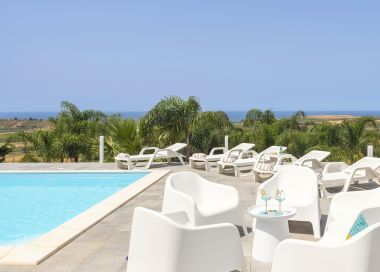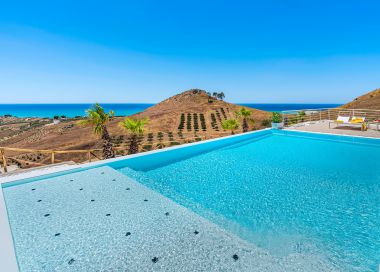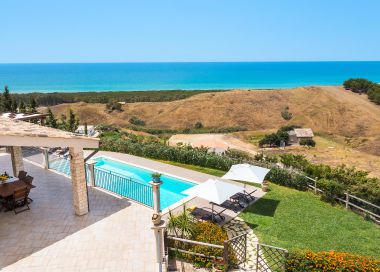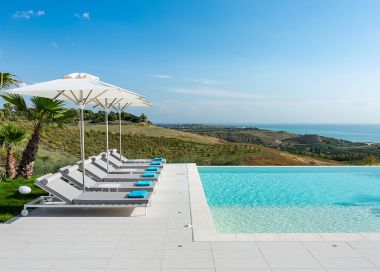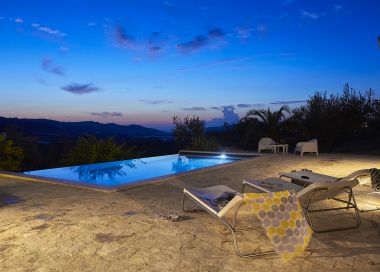Sciacca
Sciacca, thermal baths and the Sicilian carnival
Coloured houses that seem to fold back into themselves and start rolling towards the water to join the harbour and the boats cramming along the quay. Sciacca, as viewed from the sea, appears like a big Lego building set created by a child. Not devoid of an intriguing chromatic harmony, this small town that overlooks south to Africa is a swarming crossroad of ethnicities that find their deepest roots in this town’s Greek, Roman and Arab origins. Sciacca has always been a sought-after place in ancient times because it was rich in mineral sulphuric waters with great therapeutic qualities and for the presence of vaporous caves called “the stoves of St. Calogero” (great for a sauna) that had already started to be known and appreciated in Greek times. During the Arab dominion in 840, the city acquired its definitive name and flourished through a period of great prosperity. After the Norman conquest, Sciacca went through a period when several contestant families wanted to extert control over it. One of these was the Luna family, whom we owe the construction of the magnificent Luna Castle, seat of various cultural events today. Later on, the town suffered numerous earthquakes and rebellions that led to starvation and misery. Its misery nothwistanding, and also thanks to the help of Spanish and Austrian rulers, Sciacca developed into a trading centre primarily through the transporation of goods by sea and its strategic location. Today, the town owes its development to its fishing fleet (second-placed for its importance in Sicily), its tourist activities which are mainly linked to Sciacca’s thermal resorts, and the beauty of its uncontaminated beaches. Other cultural riches of the “Saccensi” (as the inhabitants of Sciacca are called) are linked with customs and traditions: the production of Maiolicas for instance that can be admired and bought in its numerous little stores, as well as the warmly celebrated and ancient Carnival, one of the most exhilarating festivals in the Sicilian tradition. As in many genuine Sicilian centres, Sciacca's road maze does not seem encouraging at first. Gradually though, it will embrace and surprise you with grandiose views and sumptuous palaces. One example is Piazza Scandaliato, a true belvedere terrace overlooking the sea and the multi-coloured harbour. Further down, the Norman Piazza Duomo reveals itself, of which only the exterior of the three apses remains preserved. On its right lies the main street (“corso”) Chiesa Madre Vittorio Emanuele, flanked by prestigious buidlings such as Palazzo Tagliavia (the beautiful facade of which is crowned with turrets and marked by three arched portals and a three-light Gothic mullioned window). The ruins of the Conti Luna Castle, dating back to the XIV century, the Norman Chiesa di San Nicolò, the eighteenth century Palazzi Inveges and Ragusa, are only samples of Palazzo Steripinto (at the corner with Corso Vittorio Emanuele and P. Gerardi road), a few steps from the Main Gate of San Salvatore and the Chiesa del Carmine. This Catalan-style Palazzo from the fifteenth century expresses itself originally through its ashlar masonry, its two-light Gothic mullioned windows and its Ghibelline merlons. But almost everywhere in Sciacca one is astonished by the variety and the layering of styles, from details such as its bellied balcony railings, its portals, its two-light mullioned windows, and the numerous traces of a multiplicity of cultures that are found in Palazzo Steripinto and in other monument buildings. Moreover, Sciacca takes on an unexpectedly sumptuous yet slightly decadent atmosphere around the Spa area. Within the so-called “Valle dei Bagni” (“Bath Valley”) lies the nineneteenth century Thermal Resort (fully restored), while the new Spa complex dates back to 1938. This large neo art nouveau style complex cannot be missed. Located high from sea level, it is surrounded by a beautiful park at the south-east end of the town. Another thermal complex is to be found in Molinelli. Going out of Figuli road towards Agrigento, another surprise lies a few kilometres away from Sciacca: the Enchanted Castle. This is really an incredible garden filled with heads carved in stone by its owner Filippo Bentivegna, nicknamed “Filippu delli Testi” (“Filippo of the Heads”). The faces and the expressions of these sculptures, realised in the enchanted castle over half a century, communicate a powerful magnetism which is hard to handle at times. However, the real tourist attraction in Sciacca is the Carnival, which traces its origins back to Roman times. For over a century, every year in March a parade of allegorical chariots has run its course from Piazza Friscia through the historic town centre to the rhythm of dances, musics, choreographic scenes and masquarades. The festival culminates in a bonfire - the burning of “Peppe Nappa’s” effigy (a symbolic figure representing the king of the Carnival) - and fireworks display.






